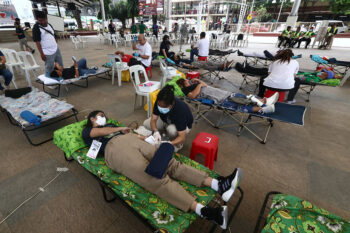GENERAL SANTOS CITY—(MindaNews/ 26 October) Images not only of flooded streets but entire villages used to be unthinkable for those who have been living in General Santos before it became a city.
Wednesday’s torrential rains, which lasted for at least six hours, inundated at least six villages in the city long after the last drops of the rain were gone.
In 1969, when my parents ‘resettled’ in this place, the only concrete streets were Pioneer Avenue and a portion of then Albert Morrow Blvd (now P. Acharon).
But then life was simple. When it rains, no matter how heavy the downpour, within hours (if not minutes) the water is gone – seeped deep below the surface. Yes, there were some waterlogs which leave behind chocolaty albeit murky water but they were like potholes in your living room you could easily dry with your floor mat.
Not anymore.
If you are lucky, you can still lie in your bed with an inch or two of water on the floor and wait till it subsides maybe in 30 minutes or so.
But for the first time in their lives Wednesday evening, some 70 families in Purok Balite in Lagao left their homes for the comfort of the dry concrete floors of the village hall as rising waters threatened to drown their children.
It is easy to blame climate change and global warming for this recurring problem that is becoming a metropolitan scourge. Of course it is not entirely correct and, even more so, true to entirely blame changing weather pattern.
Urban blight coupled with unforgivable lack of foresight played the major role in the rising problem of flooding in the city.
The natural waterways in the city are now gone if not claimed by urban settlement.
There used to be a small waterway that crossed near the ‘intersection’ (that is what the junction near dxCP was known to old time residents) passing through what is now Gaisano and Socoteco II office. That waterway stretches all the way to side of Coca-Cola Bottling Plant (where AASI village now stands) before spilling into the bay passing through a small creek beside the old Caltex Bulk Depot.
In Lagao, rainwater from Conel passes through what is now Yanzon Village going to Balite and Pag-asa before draining into the catch basin that is now Gensanville.
But some crazy guy built a wall somewhere there. Poor fellows in Yanzon village, they became lake denizens whenever it rains hard. Mind you, motorists passing by near the Lagao public market need some floaters too lest they leave their vehicles stuck in high waters.
You wonder why NLSA Road is so crooked a road? No, it is not because a Bicolano geodetic engineer skipped every hot chili plant while surveying a proposed road. The NLSA followed the contour of a stream that drains into the Amao swamp area in Bula. Do you still see the stream there?
So what gives?
In 1996, the Japan International Cooperation Agency offered the Philippine government a multi-million peso grant for the construction of a drainage system in select cities and heavily populated urban areas in the country.
General Santos City was among these areas that were considered by the grant, which comes as a soft loan.
The amount was something like P375 million. There were initial discussions and agreements in principle between the Department of the Interior and Local Government (DILG) and concerned local government units. But these were scuttled when a change in local leadership took place. It was never reconsidered.
Fifteen years since that proposal was made, the city is now looking back. Was it a wise choice to reject the offer? At that time, maybe. But then again, maybe not.
Over the last five years, the city government has been granting permits and licenses for subdivision developers as demand for housing units grew together with the ever increasing population in the city. By the way, General Santos City’s annual population growth is among the country’s fastest. Between 1995 to 2000, the annual population growth was at 5.05 percent. Between 2000 and 2007, it was 3.53 annually. And in 10 years after it became a chartered city in 1967, its population growth was a whooping 10.3 per cent.
City Administrator and former city councilor Jose Mariano Constantino said the city government is open to imposing a moratorium on permits for subdivision developments in flood-prone areas as well as in higher grounds as the city’s drainage ways can no longer cope up with the volume of drain water that passes through the narrow canals and ditches.
He said a budget has been set aside to finish the Bula-Lagao Road drain canal. Well good luck to the city government. But that hardly will drain anything until a drainage master plan that is at least 10 years ahead of any future infrastructure and housing projects is in place.
Well, the consolation and ‘silver lining’ to all this is that the city has arrived – as a metropolis.
Here come the floods! (Edwin G. Espejo writes for www.asiancorrespondent.com)







